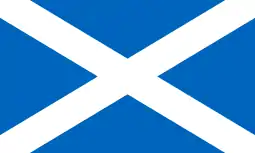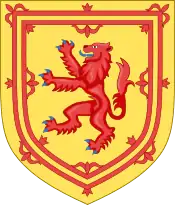History of the Jews in Scotland
The history of the Jews in Scotland goes back to at least the 17th century. It is not known when Jews first arrived in Scotland, with the earliest concrete historical references to a Jewish presence in Scotland being from the late 17th century.[3] Most Scottish Jews today are of Ashkenazi background who mainly settled in Edinburgh, then in Glasgow in the mid 19th century.
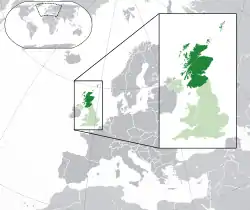
| Total population | |
|---|---|
| 5,887 (according to 2011 census)[1] | |
| Regions with significant populations | |
| East Renfrewshire,[2] Edinburgh, Glasgow, Dundee | |
| Languages | |
| Scottish English, Scots, Scottish Gaelic, Hebrew, Yiddish | |
| Religion | |
| Judaism |
| Part of a series on |
| Jews and Judaism |
|---|
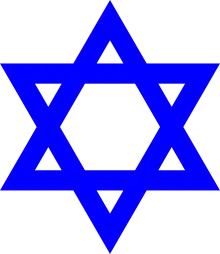 |
|
Part of a series on the |
|---|
| History of Scotland |
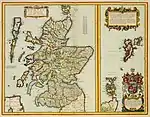 |
|
|
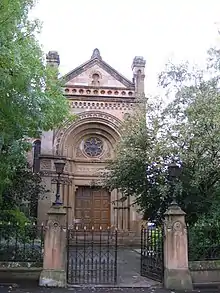
According to the 2011 census, 5,887 Jews lived in Scotland; a decline of 8.7% from the 2001 census.[1] The total population of Scotland at the time was 5,313,600, making Scottish Jews 0.1% of the population.
Middle Ages to union with England
There is only scant evidence of a Jewish presence in medieval Scotland. In 1180, the Bishop of Glasgow forbade churchmen to "ledge their benefices for money borrowed from Jews".[4] This was around the time of anti-Jewish riots in England so it is possible that Jews may have arrived in Scotland as refugees, or it may refer to Jews domiciled in England from whom Scots were borrowing money.
In the Middle Ages, much of Scotland's trade was with continental Europe, with wool of the Borders abbeys being the country's main export to Flanders and the Low Countries. Scottish merchants from Aberdeen and Dundee had close trading links to Baltic ports in Poland and Lithuania. It is possible, therefore, that Jews may have come to Scotland to do business with their Scottish counterparts, although no direct evidence of this exists.[5]
The late-18th-century author Henry Mackenzie speculated that the high incidence of biblical place names around the village of Morningside near Edinburgh might indicate that Jews had settled in the area during the Middle Ages. This belief has, however, been shown to be incorrect, with the names originating instead from the presence of a local farm named "Egypt" mentioned in historical documents from the 16th century and believed to indicate a Romani presence.[6]
17th–19th centuries
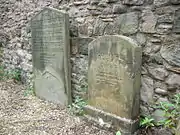
The first recorded Jew in Edinburgh was one David Brown who made a successful application to reside and trade in the city in 1691.[7]
Most Jewish immigration appears to have occurred post-industrialisation, and post-1707, by which time Jews in Scotland were subject to various anti-Jewish laws that applied to Britain as a whole. Oliver Cromwell readmitted Jews to the Commonwealth of England in 1656, and would have had influence over whether they could reside north of the border. Scotland was under the jurisdiction of the Jew Bill, enacted in 1753, but repealed the next year.
The first graduate from the University of Glasgow who was openly known to be Jewish was Levi Myers, in 1787. Unlike their English contemporaries, Scottish students were not required to take a religious oath.
In 1795, Herman Lyon, a dentist and chiropodist, bought a burial plot in Edinburgh. Originally from Mogendorf, Germany he left there around 1764 and spent some time in Holland before arriving in London. He moved to Scotland in 1788. The presence of the plot on Calton Hill is no longer obvious today, but it is marked on the Ordnance Survey map of 1852 as "Jew's Burial vault".[7]
The first Jewish congregation in Edinburgh was founded in 1816, when the Edinburgh community consisted of 20 families.[7] The first congregation in Glasgow was founded in 1821, and that of Aberdeen was founded in 1893. The Jewish cemetery in Dundee indicates that there has been a Jewish congregation in that city since the 19th century.
Isaac Cohen, a hatter resident in Glasgow, was admitted a burgess of the city on 22 September 1812. The first interment on the Glasgow Necropolis was that of Joseph Levi, a quill merchant and cholera victim who was buried there on 12 September 1832. This occurred in the year before the formal opening of the burial ground, a part of it having been sold to the Jewish community beforehand for one hundred guineas.[8] Glasgow-born Asher Asher (1837–1889) was the first Scottish Jew to enter the medical profession. He was the author of The Jewish Rite of Circumcision (1873).
In 1878, Jewish Hannah de Rothschild (1851–1890), the richest woman in Britain at the time, married Scottish aristocrat Archibald Primrose, 5th Earl of Rosebery, despite strong antisemitic sentiments in court and the aristocracy. They had four children. Their son, Harry, would become Secretary of State for Scotland in 1945 during Winston Churchill's postwar caretaker government.
To avoid persecution and pogroms in the Russian Empire in the 1880s, many Jews settled in the larger cities of Britain, including Scotland, most notably in Glasgow (especially the poorer part of the city, the Gorbals, alongside Irish and Italian immigrants).[9] A smaller community existed in Edinburgh and even smaller groups in Dundee, Aberdeen, Greenock and Ayr. Russian Jews tended to come from the west of the empire, in particular Lithuania and Poland, hoping to use Scotland as a stopping post en route to North America. This explains why Glasgow was their favoured location. However, those who were not able to earn enough to afford the transatlantic voyage ended up settling in the city.[10] In 1897, after the influx, the Jewish population of Glasgow was 4,000.[11]
20th and 21st centuries
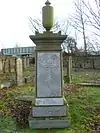
Immigration continued into the 20th century, with over 9,000 Jews in 1901 and around 12,000 in 1911. Refugees from Nazi Germany and the Second World War further augmented the Scottish Jewish community, which has been estimated to have reached over 20,000 in the mid-20th century. By way of comparison, the Jewish population in the United Kingdom peaked at 500,000, but declined to just over half that number by 2008.[12]

The practising Jewish population continues to fall in Scotland, as many younger Jews either became secular, or intermarried with other faiths. Scottish Jews have also emigrated in large numbers to England, the United States, Canada, Australia and New Zealand for economic reasons, as other Scots have done. According to the 2001 census, 6,448 Jews lived in Scotland,[13] According to the 2011 census, 5,887 Jews lived in Scotland; a decline of 8.7% from 2001.[1][14] Most live in Glasgow (4,249), with smaller populations in Edinburgh (about 934) and Dundee.[14] Scotland's Jewish population continues to be predominantly urban. Approximately 41% of Scotland's Jewish population resides in the East Renfrewshire area, with approximately 25% in the suburban town of Newton Mearns,[2] with their families having moved steadily southwards from central Glasgow to more prosperous outer parts of the city over the generations.[9]
In March 2008 a Jewish tartan was designed by Brian Wilton[15] for Chabad rabbi Mendel Jacobs of Glasgow and certified by the Scottish Tartans Authority.[16] The tartan's colors are blue, white, silver, red and gold. According to Jacobs: "The blue and white represent the colours of the Scottish and Israeli flags, with the central gold line representing the gold from the Biblical Tabernacle, the Ark of the Covenant and the many ceremonial vessels ... the silver is from the decorations that adorn the Scroll of Law and the red represents the traditional red Kiddush wine."[17]
Jewish communities in Scotland are represented by the Scottish Council of Jewish Communities.
Antisemitism
In the Middle Ages, while Jews in England faced state persecution, culminating in the Edict of Expulsion of 1290 (some Jews may have moved to Scotland at this time[18]) there was never a corresponding expulsion from Scotland, suggesting either greater religious tolerance or the simple fact that there wasn't a Jewish presence. In his autobiographical, Two Worlds: An Edinburgh Jewish Childhood, the eminent Scottish-Jewish scholar David Daiches wrote that there are grounds for asserting that Scotland is the only European country with no history of state persecution of Jews.
Some elements of the British Union of Fascists formed in 1932 were anti-Jewish and Alexander Raven Thomson, one of its main ideologues, was a Scot. Blackshirt meetings were physically attacked in Edinburgh by communists and "Protestant Action", which believed the group to be an Italian (i.e. Roman Catholic) intrusion.[19] In fact, William Kenefick of Dundee University has claimed that bigotry was diverted away from Jews by anti-Catholicism, particularly in Glasgow where the main ethnic chauvinist agitation was against Irish Catholics.[20] Archibald Maule Ramsay, a Scottish Unionist MP claimed that World War II was a "Jewish war" and was the only MP in the UK interned under Defence Regulation 18B. In the Gorbals at least, neither Louise Sless nor Woolf Silver recall antisemitic sentiment.[21] (See also Jews escaping from Nazi Europe to Britain.)
In 2012, the Scottish Jewish Student Chaplaincy and the Scottish Council of Jewish Communities reported a "toxic atmosphere" at the University of Edinburgh, in which Jewish students were forced to hide their identity.[22]
In September 2013, the Scottish Council of Jewish Communities published the "Being Jewish in Scotland" project, which researched the situation of Jewish people in Scotland through interviews and focus group attended by approximately 180 participants. The report included data from the Community Security Trust that, during 2011, there were 10 antisemitic incidents of abusive behavior, 9 incidents of damage and desecration to Jewish property, and one assault. Some participants described experiences of antisemitism in their workplace, campus and at school.[23]
During Operation Protective Edge, in August 2014, the Scottish Council of Jewish Communities reported a sharp increase in antisemitic incidents. During the first week of August, there were 12 antisemitic incidents – almost as many as in the whole of 2013.[24] A few months later, an irritating chemical was thrown on a member of staff selling Kedem (Israeli cosmetics) products in Glasgow's St Enoch Centre.[25] In 2015, the Scottish government published statistics on abusive behaviour in Religiously Aggravated Offending in Scotland in 2014–15, covering the Protective Edge period, which noted an increase in the number of charges filed for anti-Jewish acts from 9 in 2014 (2% of those charged with religious offences) to 25 in 2015 (4% of total). Most dealt with "threatening and abusive behavior" and "offensive communications". The penalty imposed on those convicted was typically a fine.[26]
"Scots-Yiddish"
Scots-Yiddish is the name given to a Jewish hybrid vernacular between Lowland Scots and Yiddish, which had a brief currency in the Lowlands in the first half of the 20th century. The Scottish literary historian David Daiches describes it in his autobiographical account of his Edinburgh Jewish childhood, Two Worlds.[27]
Daiches explores the social stratification of Edinburgh's Jewish society in the interwar period, noting what is effectively a class divide between two parts of the community, on the one hand a highly educated and well-integrated group who sought a synthesis of Orthodox Rabbinical and modern secular thinking, on the other a Yiddish-speaking group most comfortable maintaining the lifestyle of the Eastern European ghetto. The Yiddish population grew up in Scotland in the 19th century, but by the late 20th century had mostly switched to using English. The creolisation of Yiddish with Scots was therefore a phenomenon of the middle part of this period.
The Glaswegian Jewish poet A. C. Jacobs also refers to his language as Scots-Yiddish.[28] There was even a case of a Jewish immigrant who settled in the Highlands who spoke no English and was only able to speak Gaelic and Yiddish.[29]
List of Scottish Jews
- Ronni Ancona, comedian[30]
- Hazel, Lady Cosgrove[31] first female Court of Session judge
- Ivor Cutler, musician, teacher and comedian
- Noam Dar, professional wrestler
- Sir Monty Finniston, industrialist
- Isla Fisher, ethnically Scottish, but converted to Judaism as an adult[32]
- Hannah Frank, artist and sculptor
- Myer Lord Galpern MP, Lord Provost of Glasgow
- Ralph Glasser, psychologist and economist (born in Leeds but grew up in Glasgow)
- Professor Sir Abraham Goldberg KB MD DSc FRCP FRSE, leading medical academic
- Muriel Gray, author and presenter of The Tube
- Jeremy Isaacs, broadcaster
- Mark Knopfler, Dire Straits co-founder and lead guitarist, lead vocalist
- Kevin Macdonald, director, known for Touching the Void
- Isi Metzstein, architect
- Saul Metzstein, filmmaker
- Neil Primrose, MP and soldier, Jewish mother
- Malcolm Rifkind, politician
- Harry Primrose, 6th Earl of Rosebery, Secretary of State for Scotland, Jewish mother
- Jerry Sadowitz, controversial comedian and conjurer
- Benno Schotz, sculptor
- Manny Shinwell, politician
- J. David Simons, novelist
- Dame Muriel Spark, novelist[33]
- Harry, Lord Woolf, judge, brought up and educated in Scotland
See also
Notes and references
- "Scotland's Census 2011 – Table KS209SCb" (PDF). scotlandscensus.gov.uk. Retrieved 26 September 2013.,
- "2011 Standard Outputs". Scotland's Census. Retrieved 23 September 2016.
- Daiches, Salis (1929). The Jew in Scotland. Scottish Church History Society. pp. 196–209. Retrieved 25 August 2018.
- "Scotland Virtual Jewish History Tour". Jewish Virtual Library. Retrieved 12 September 2019.
- "Edinburgh Jewish Community". Electric Scotland. Retrieved 12 September 2019.
- C J Smith, Historic South Edinburgh, Edinburgh & London 1978, p.205 "At the distance of less than a mile from Edinburgh there are places with Jewish names—Canaan, the river or brook called Jordan, Egypt—a place called Transylvania, a little to the east of Egypt. There are two traditions of the way in which they got their names: one, that there was a considerable eruption of gypsies into the county of Edinburgh who got a grant of these lands, then chiefly a moor; the other, which I have heard from rather better authority, that some rich Jews happened to migrate into Scotland and got from one of the Kings (James I, I think it was said) a grant of these lands in consideration of a sum of money which they advanced him."
- "Edinburgh Jewish History". Edinburgh Jewish Community. Retrieved 12 September 2019.
- D Daiches, Glasgow, Andre Deutsch, 1977, p.139-40
- Pupils at Queen's Park Secondary 1936 (Scottish Jewish Archives Centre), The Glasgow Story
- R Glasser, Growing Up in the Gorbals, Chatto & Windus, 1986
- "The Jewish Community of Glasgow". The Museum of the Jewish People at Beit Hatfutsot. Retrieved 25 June 2018.
- Pigott, Robert (21 May 2008). "Jewish population on the increase". BBC News.
- ceu@scotland.gsi.gov.uk, Scottish Government, St. Andrew's House, Regent Road, Edinburgh EH1 3DG Tel:0131 556 8400 (28 February 2005). "Analysis of Religion in the 2001 Census". scotland.gov.uk.
- "Census 2011".
- "Jewish Tartan". Scottish Tartans Authority. Retrieved 1 May 2010.
- Schwartzapfel, Beth (17 July 2008). "Sound the Bagpipes: Scots Design Jewish Tartan". Forward. Retrieved 1 May 2010.
- Hamilton, Tom (16 May 2008). "Rabbi creates first official Jewish tartan". Daily Record. Retrieved 1 May 2010.
- Caldwell Hirschman, Elizabeth; Yates, Donald N. (2007), When Scotland Was Jewish, ISBN 978-0-7864-2800-7, archived from the original on 26 September 2011, retrieved 15 April 2008
- Cullen, Stephen (26 December 2008), "Nationalism and sectarianism 'stopped rise of Scots fascists'", Herald
- Boztas, Senay (17 October 2004), "Why Scotland has never hated Jews ... it was too busy hating Catholics", Sunday Herald, archived from the original on 31 January 2006, retrieved 1 May 2010
- Fleischmann, Kurt. "The Gorbals and the Jews of Glasgow". European Sephardic Institute.
- "Jewish students warn of 'toxic' atmosphere at uni". The Scotsman. 15 December 2012. Retrieved 12 January 2015.
- Granat, Leah; Borowski, Ephraim; Frank, Fiona. "Being Jewish in Scotland" (PDF). The Scottish Council of Jewish Communities (scojec). Retrieved 12 January 2015.
- "Large Spike in Antisemitic Incidents in Scotland". The Scottish Council of Jewish Communities. Retrieved 11 January 2015.
- "Kedem staff member doused in 'burning' chemical in hate attack". Jewish Chronicle. Retrieved 18 August 2015.
- Davidson, Neil. "Religiously Aggravated Offending in Scotland in 2014–15" (PDF). Justice Analytical Services – The Scottish Government. Retrieved 29 June 2015.
- David Daiches, Two Worlds, 1956, Cannnongate edition 1987, ISBN 0-86241-148-3, p. 119f.
- Relich, Mario. "The Strange Case of A. C. Jacobs" (PDF). Archived from the original (PDF) on 30 September 2006.
- "Scotland's Century" (RealPlayer). BBC Radio Scotland. 1999.
- Diary p. 66, "Could there be a hint of racial stereotyping in the Almeida's decision to cast two Jewish actors – Ronni Ancona and Henry Goodman – in its upcoming production of The Hypochondriac?", Jewish Chronicle, 28 September 2005,
- "Feature article". Culham College Institute. Archived from the original on 20 October 2007.
- Simpson, Richard; Weaver, Clair (4 March 2004). "I is marrying me Julie". Evening Standard. London. Archived from the original on 18 December 2011. Retrieved 21 July 2011.
- Jewish father; mother Anglican but Muriel Spark's son says that she had Jewish parents; converted to Catholicism later in life
Further reading
- Collins Dr. KE, Borowski E, and Granat L – Scotland's Jews – A Guide to the History and Community of the Jews in Scotland (2008)
- Levy, A – The Origins of Scottish Jewry
- Phillips, Abel – A History of the Origins of the First Jewish Community in Scotland: Edinburgh, 1816 (1979)
- Glasser, R – Growing Up in the Gorbals, Chatto & Windus (1986)
- Shinwell, Manny – Conflict Without Malice (1955) – autobiography
- Conn, A (editor) – Serving Their Country- Wartime Memories of Scottish Jews (2002)
- Kaplan, H L – Jewish Cemeteries in Scotland in Avotaynu, Vol.VII No 4, Winter 1991
External links
- Jewish Year Book (JYB)
- Daiches, David (1956), Two Worlds, Cannnongate edition 1987, p. 119f, ISBN 0-86241-148-3
- Jewish Community of Edinburgh - Chabad on Campus
- Scottish Council of Jewish Communities
- Jewish Encyclopedia on Scotland
- Scottish Jewish Archives Centre
- Edinburgh Burgh Records, 1691
- The Virtual Jewish History Tour – Scotland
- Jewish burial ground in the Glasgow Necropolis
- Edinburgh Hebrew Congregation
- Aberdeen Hebrew Congregation
- Sukkat Shalom Edinburgh – the Edinburgh Liberal Jewish Community
- The Secret Yiddish History of Scotland
